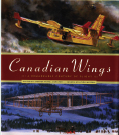
Features
Operations
CANADIAN WINGS – A Remarkable Century of Flight
As we all know, 2009 is an important year in Canada’s history. It is the year that marks the centennial of powered flight in Canada. 100 years ago, on February 23, 1909, the Silver Dart, an experimental aircraft piloted by Canadian aviation pioneer J.A.D. McCurdy,
February 3, 2009 By Christina Lucas
As we all know, 2009 is an important year in Canada’s history. It is the year that marks the centennial of powered flight in Canada. 100 years ago, on February 23, 1909, the Silver Dart, an experimental aircraft piloted by Canadian aviation pioneer J.A.D. McCurdy, a member of Alexander Graham Bell’s Aerial Experiment Association (A.E.A.), took off from Baddeck, Nova Scotia, achieving the first powered and controlled flight in our country.
To commemorate this significant milestone, the Canada Aviation Museum will open its newest exhibition, Canadian Wings: A Remarkable Century of Flight, in late February 2009. Museum visitors will discover the rich aeronautical heritage that has been established in this country since that first tentative flight.
The exhibition features four key themes:
Getting Into the Air (and Staying There): 1902-1918 is a tribute to the earliest days of aviation and examines the “Wonderful World of Flying Machines,” "Understanding Flight,” and the impressive aviation innovations developed during the course of the First World War. Of special interest is the reproduction of the Silver Dart.
| Canadian Wings A Remarkable Century of Flight Lavishly illustrated and richly told, this stunning tribute to the pioneers of northern aviation and their daredevil feats puts Canadian achievements in their rightful place on the world stage. Author Stephen Payne is the curator of aeronautical technology at the Canada Aviation Museum. |
|
 |
Tying the Country Together: 1919-1938 explores how powered flight connected Canada and Canadians in entirely new ways. Visitors will undoubtedly take pride in the truly Canadian concept of bush flying.
This period of ‘firsts’ included groundbreaking flights that inspired the imagination and cemented aviation in our collective consciousness. Highlighted are iconic bush aircraft such as the Curtiss HS-2L La Vigilance, the Noorduyn Norseman and the de Havilland Canada Beaver that played important roles in connecting Canadians by moving freight, mail and passengers in Canada’s more inaccessible areas.
Industry and War: 1939-1945 demonstrates the Second World War’s role as a catalyst for growth in all segments of aviation. During this relatively short period of time, a rapid pace of innovation and change took place that included the emergence of a Canadian aircraft manufacturing industry and the development of the impressive British Commonwealth Air Training Plan which trained over 130,000 airmen for service overseas. Many of the aircraft from this period, such as the North American Harvard and the Avro Lancaster, still hold a particular significance in the lives of many Canadians.
Shrinking the World: 1946 to Present illustrates a period of growth in commercial aviation that is represented by aircraft such as the Douglas DC-3 and the Bombardier Challenger. The emergence of the airline industry has served Canadians in the remote North as well as urban areas, and has brought new Canadians from around the world to their new homes in this country. One of Trans-Canada Air Lines’ first Lockheed 10As and the Boeing 247, the world’s first modern airliner, are rare artefacts from the 1930s that represent the dawn of airline travel. The exhibition continues its march in time by highlighting more recent developments, such as Cold War technology. Some of the impressive aircraft that served with the RCAF and/or the Canadian Forces during this era, such as the Canadair Sabre, and the record-setting Lockheed Starfighter, are displayed.This journey continues as Canada’s entrance to the jet age follows with a collection that features Canada’s first jet fighter, the de Havilland Vampire, the only remaining section of the legendary Avro Canada CF-105 Arrow, and the contemporary CF-18 Hornet, to name only a few. Two specialized aspects of aviation history, naval and rotary-wing aircraft, are also represented. Fascinating naval aircraft, with their “folding wings” include the eminent Fairey Swordfish of Second World War fame, and the Museum’s helicopter display that features the last Boeing Vertol Labrador to fly with the Canadian Forces, with its life-saving legacy and many stories to tell. Aviation has truly played a significant role in the growth and prosperity of Canada and still does today. The Canada Aviation Museum is an institution dedicated to the preservation of this aspect of Canada’s heritage.